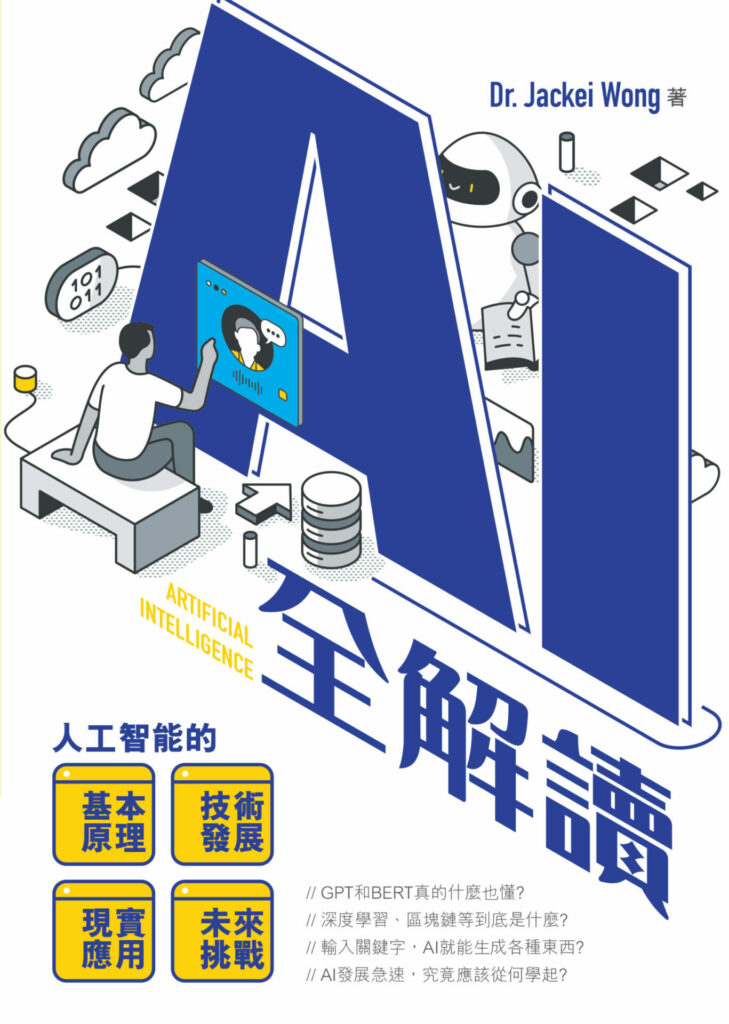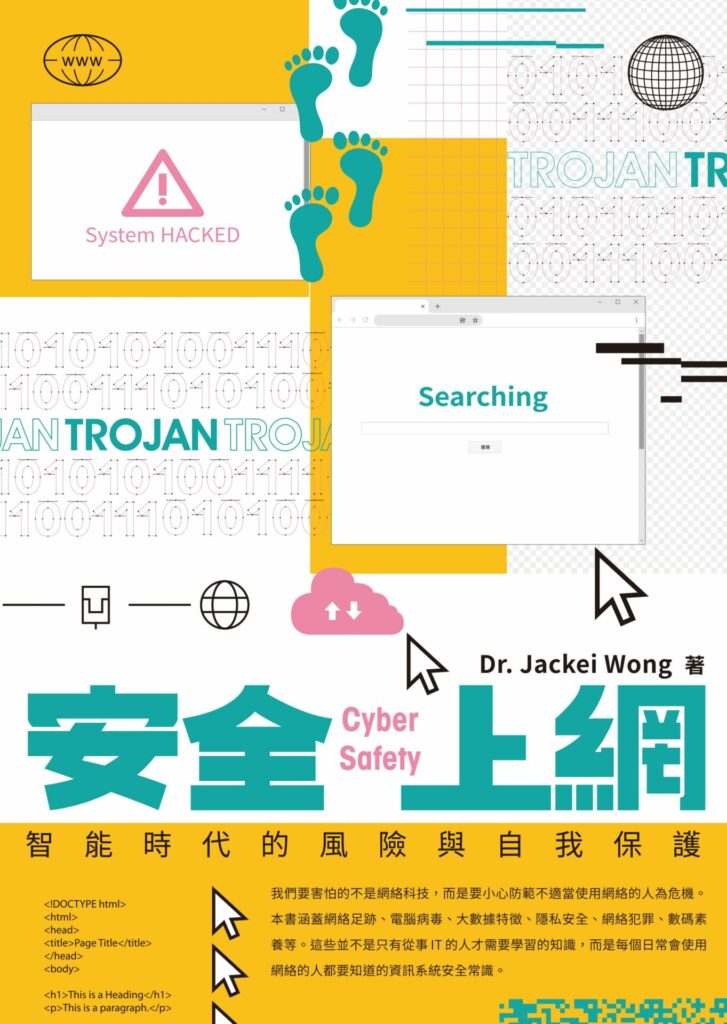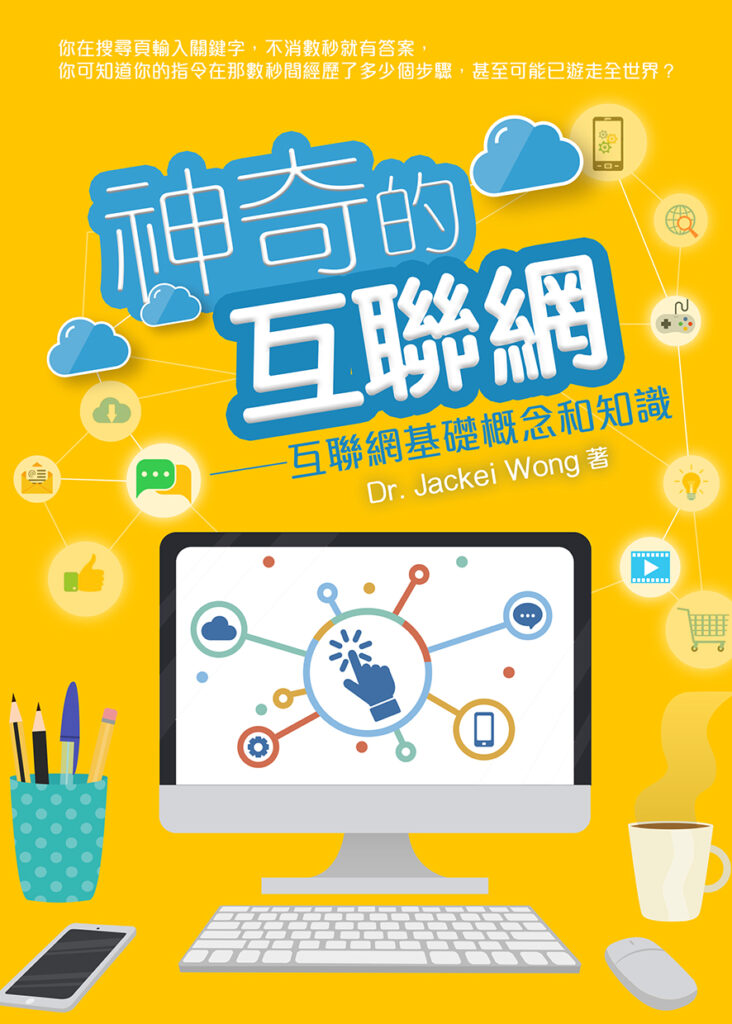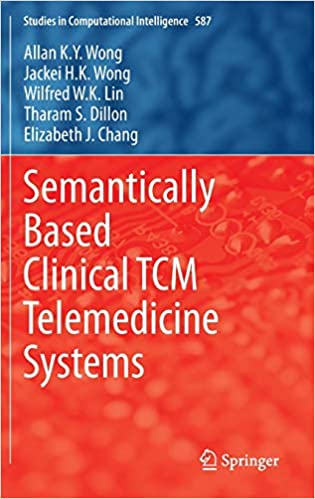
| 書名:AI全解讀——人工智能的基本原理、技術發展、現實應用和未來挑戰 |
| 作者:Dr. Jackei Wong |
| 出版社:花千樹出版社 |
| 出版日期: May 2024 |
| ISBN:978-988-8789-27-6 |
| 人工智能(AI)是什麼?它是電腦科學的一個分支,專注於創建能模仿人類智能行為的機器或軟件,包括學習、推理、感知和創造力。 事實上AI已深深融入我們的日常生活,例如Siri的語音識別、手機臉部解鎖的人臉辨識、網上解答各種查詢的聊天機械人等。 本書從AI的早期發展、基本原理和不同硬件說起,然後講解將人類的自然語言和機器演算法相互連接的自然語言處理(NLP),以及其衍生的多種工具和技術,例如不少人都聽過的GPT和BERT,它們彷彿無所不知﹗ 現在的人工智能生成內容(AIGC)甚至不需要我們告訴機器每個細節,它都能自動生成文字、圖片、音樂、影像等,而虛擬實境(VR)和擴增實境(AR)更透過AI應用,在真實世界中創造出沉浸式的體驗。 此外,書中亦會介紹AI應用在醫療、金融、教育、交通、物流、家居生活等領域的不同實例,讀者可以了解AI如何減少成本和錯誤率,提升工作和服務效率,並為每個人的生活提供各種便利。而經常聽到的「大數據」、「區塊鏈」、「元宇宙」、「虛擬貨幣」、「智能合約」等,原來都跟AI息息相關。 AI的概念往往被誤解或簡化,令許多人對於哪些應用屬於AI存在困惑。掌握AI的基礎能幫助我們對這個世界有更全面的理解,並提升競爭力,為未來的職業生涯或個人興趣開啟新的可能。 AI時代的來臨,正好提醒我們必須不斷學習和適應,你還在等什麼? |

| 書名:安全上網——智能時代的風險與自我保護 |
| 作者:Dr. Jackei Wong |
| 出版社:花千樹出版社 |
| 出版日期: Jun 2022 |
| ISBN:978-988-8484-98-0 |
| 有沒有留意自己每天上網的時間是多少?據統計,全球的網絡使用者平均上網時間近七小時,即除了休息時間外,接近一半時間都在上網!互聯網平台比父母更了解你,這已是不爭的事實。 互聯網發展得越成熟,我們在參與所有互聯網活動時留下的足跡便越多。要發展互聯網,就需要了解所有互聯網使用者的背景、喜好、習慣,甚至期望。我們在求Google大神幫忙時,其實我們亦在幫助它收集數據。不同的免費社交平台為我們帶來方便,但你有否想過,免費的事,代價往往最高? 在現實世界中,大家會有意識如何保護個人資料,免被第三方未經授權使用。但在人工智能及大數據急速發展的時代,所有事情「互聯網化」後,你又是否懂得保護自己? 除了保護個人身份,保持健康也十分重要,電腦和人一樣也會受病毒威脅,先了解惡意軟件、電腦病毒和駭客的定義及其特性,再針對個別項目作出應對措施,那麼即使遇到類似情況,亦可自己動手作診斷,甚至修復系統。 多了解網絡風險及自我保護方法,做一個精明的互聯網使用者,時刻緊記:關於你的個人資料保護,你都有選擇權! |

| 書名:神奇的互聯網——互聯網基礎概念和知識 |
| 作者:Dr. Jackei Wong |
| 出版社:花千樹出版社 |
| 出版日期: Jul 2020 |
| ISBN:978-988-8484-69-0 |
| 我們的生活每天都倚賴著互聯網,無論是通訊、學習、看網上視頻、查看巴士班次、網上購物、玩網絡遊戲等。在這個「互聯網時代」,只要在瀏覽器輸入關鍵字,不消數秒便能知天下事,你知道這看來不費吹灰之力的步驟,當中的運作是怎樣的嗎?你是如何一步一步連到互聯網世界並進行互動的? 是誰發明互聯網的?為什麼要發明它? 互聯網和萬維網是同一樣東西嗎? Web 1.0、Web 2.0及Web 3.0有什麼分別? 1G、2G、3G、4G、5G有什麼不同? IP位址的那堆數字是怎樣組成的? 為什麼有時HTTP後面會有S? 瀏覽一些網頁時彈出來的Cookie究竟是什麼? 本書從互聯網最基礎的知識和歷史開始,由淺入深地講解互聯網的演進和運作過程。沒有這基礎,很多事情就不會發生了,每天都頻繁地使用互聯網服務的你,又豈能不知道? |

| Book Title: Semantically Based Clinical TCM Telemedicine Systems (Studies in Computational Intelligence, 587) |
| Author: Allan K. Y. Wong, Jackei H.K. Wong, Wilfred W. K. Lin, Tharam S. Dillon & Elizabeth J. Chang |
| Publisher: Springer |
| Publication Date: Feb 2015 |
| ISBN-13: 978-3-662-46024-5 |
| Presents the convergence of the adoption of some Traditional Chinese Medicine (TCM) Practices into mainstream Allopathic Western Medicine. Pioneering work in the field of semantically based TCM telemedicine systems. Increases the understanding of semantically based clinical TCM telemedicine systems and clarifies how different technologies can be put together to implement a workable system. |

| Chapter Title: Artificial Neural Network Based Chinese Medicine Diagnosis in Decision Support Manner and Herbal Ingredient Discoveries Book Title: Data Analytics for Traditional Chinese Medicine Research |
| Chapter Author: Wilfred W. K. Lin, Jackei H.K. Wong |
| Publisher: Springer |
| Publication Date: Jan 2014 |
| ISBN-13: 978-3-319-03801-8 |
| Presents a data analytic approach for an efficient way to analyze the data, to find useful patterns, to generate and validate hypothesis. Offers data mining researchers a new domain of study, an area which sits on a wealth of data untouched for development of new algorithms to address the specific nature of this field. Provides the biostatistics community and health practitioners a means to analyze Traditional Chinese Medicine (TCM). |

| Chapter Title: Text Mining for Real-time Ontology Evolution Book Title: Data Mining for Business Applications |
| Chapter Author: Jackei H.K. Wong, Tharam S. Dillon, Allan K. Y. Wong & Wilfred W. K. Lin |
| Publisher: Springer |
| Publication Date: Oct 2008 |
| ISBN-13: 978-0-387-79420-4 |
| In this paper we propose the novel technique, On-line Continuous Ontological Evolution (OCOE) approach, which applies text mining to automate TCM (Traditional Chinese Medicine) telemedicine ontology evolution. The first step of the automation process is opening up a closed skeletal TCM ontology core (TCM onto-core) for continuous evolution and absorption of new scientific knowledge. The test-bed for the OCOE verification was the production TCM telemedicine system of the Nong‘s Company Limited; Nong’s is a subsidiary of the PuraPharm Group in the Hong Kong SAR, which is dedicated to TCM telemedicine system development. At Nong’s the skeletal TCM onto-core for clinical practice is closed (does not automatically evolve). When the OCOE is combined with the Nong’s enterprise TCM onto-core it: i) invokes its text miner by default to search for new scientific findings over the open web incessantly; and ii) selectively prunes and stores useful new findings in special OCOE data structures. These data structures can be appended to the skeletal TCM onto-core logically to catalyze the evolution of the overall system TCM ontology, which is the logical combination: “original skeletal TCM onto-core plus contents of the special OCOE data structures” The evolutionary process works on the contents of the OCOE data structures only and does not alter any skeletal TCM onto-core knowledge. This onto-core evolution approach is called the “logical-knowledge-add-on” technique. OCOE deactivation will nullify the pointers and cut the association between the OCOE data structures and skeletal TCM onto-core, thus immediately reverting the clinical practice back to the original skeletal TCM onto-core basis. |
